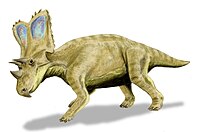ダイナソーパーク累層
| ダイナソーパーク累層 層序範囲: カンパニアン, 76.9–75.8 Ma ↓ | |
|---|---|
 レッドディア川沿いに広がるダイナソーパーク累層。 | |
| 種別 | 地層 |
| 所属 | ベリーリバー層群 |
| 上層 | ベアパウ累層 |
| 下層 | オールドマン累層 |
| 岩質 | |
| 主な岩石 |
砂岩(下部) 泥岩、シルト岩(上部) |
| その他の岩石 | ベントナイト、石炭 |
| 所在地 | |
| 地域 |
|
| 国 |
|
| 模式断面 | |
| 名の由来 | 州立恐竜公園 |
| 命名者 | Eberth, D.A. and Hamblin, A.P., 1993.[2] |
ダイナソーパーク累層 Dinosaur Park Formation(ダイナソーパーク層、恐竜公園層とも)はベリーリバー層群(ジュディスリバー層群)の最上位に堆積する、カナダ・アルバータ州の有名な地層。地質年代は白亜紀後期カンパニアン後期(7690万~7580万年前)である。[1] 沖積層と海岸の環境を保存しており、陸成層であるオールドマン累層の上に堆積し、上には海成層のベアパウ累層が堆積する[3]。
ダイナソーパーク累層は豊富な恐竜化石を含んでおり、関節したものや軟組織が残っているものも見つかっている。それ以外にも魚類、カメ、ワニ、植物の化石も大量に保存されている[4]。この層はレッドディア川沿いのユネスコ世界遺産である州立恐竜公園に因んで命名された[2]。
地質環境[編集]

ダイナソーパーク累層は西側の山脈の侵食によって運ばれた流送土砂で構成されている。それは西の内陸水路の一部であった大きな内陸海であるベアパウ海の東および南東に流れた河川系によって沿岸平野の沖に堆積した。その海は隣接する沿岸平原を徐々に浸水させ、ダイナソーパーク累層の上にベアパウ累層の海洋頁岩を堆積させた[2]。
ダイナソーパーク累層は約70メートルの厚さがある。地層の下部は河川の流路環境に敷設され、主に細かい粒度から中粒度の砂岩で構成されている。氾濫堆積物と氾濫原の環境に相当する上部は、主に多くの根軌跡を持つ有機物豊富な泥岩の塊と、ベントナイトの薄い層から構成されている。レスブリッジの石炭地帯は、泥岩とそれらが内包されたシルトの複数の薄層から成っており、地層上部に位置している[3]。
ダイナソーパークの堆積物は、前の時代のオールドマン累層のそれに類似している。しかし、2つの地層は地域的な不一致によって分離されており、岩石学および堆積岩的な相違によって区別される。さらに関節した骨格化石およびボーンベッドはオールドマン累層ではまれであるが、ダイナソーパーク累層では豊富である[3][2]。
動物相[編集]
以下の他、パキリノサウルスに類似の未命名のタクソンも発見されている。
| ダイナソーパーク累層から発見されている角竜類 | ||||||
|---|---|---|---|---|---|---|
| 属 | 種 | 場所 | 層序 | 部位 | メモ | 画像 |
|
C. apertus |
中部、7620万~7550万年前[5] |
15個の頭骨、いくつかの骨格、全て成体。珍しい亜成体、幼体を含む大量のボーンベッド[6]C. nasicornis は恐らく同物異名。 |
      | |||
|
C. belli |
中部、7600万~7550万年前[5] |
12個の頭骨、いくつかの骨格[6]。 |
||||
|
C. russelli |
下部、7650万~7600万年前[5] |
6個の完全な頭頂骨[7] | ||||
|
M. gemini[8] |
下部、7650万~7700万年前[8] |
1つの幼形の鱗状骨[8] |
カスモサウルス亜科 | |||
|
M. lowei |
疑問名、セントロサウルス亜科 | |||||
|
P. aquilonius[9] |
上部、7480万年前[9] |
2つのフリル断片[9] |
||||
|
S. sternbergorum[11] |
下部、7650万年前[11] |
部分的な頭頂骨、部分的な歯、詳細不明の肋骨の断片、部分的な頭骨、右の鱗状骨の一部[11]。 |
セントロサウルス亜科。実際はオールドマン累層上部産の可能性あり[11]。 | |||
|
S. albertensis |
上部。7550~7520万年前[5] |
2つの頭骨、3つの骨格、ボーンベッドの追加標本[6] |
セントロサウルス亜科 | |||
|
U. koppelhusae |
部分的な下顎骨[12] |
レプトケラトプス類。全長1~2メートルの間、体重91キログラム以下と思われる。レプトケラトプス類の中で最も円形に近い歯をもつ。 | ||||
|
V. irvinensis |
上部。7500万年前[5] |
3つの頭骨、尾を失った骨格[7]。 |
||||
脚注[編集]
- ^ a b Fowler, D. (2016). A new correlation of the Cretaceous formations of the Western Interior of the United States, I: Santonian-Maastrichtian formations and dinosaur biostratigraphy. Peer J Preprints.
- ^ a b c d Eberth, D.A. and Hamblin A.P. 1993. Tectonic, stratigraphic, and sedimentologic significance of a regional discontinuity in the upper Judith River Group (Belly River wedge) of southern Alberta, Saskatchewan, and northern Montana. Canadian Journal of Earth Sciences 30: 174-200.
- ^ a b c Eberth, D.A. 2005. The geology. In: Currie, P.J., and Koppelhus, E.B. (eds), Dinosaur Provincial Park: A Spectacular Ancient Ecosystem Revealed. Indiana University Press: Bloomington and Indianapolis,p.54-82. ISBN 0-253-34595-2.
- ^ Currie, P.J., and Koppelhus, E.B. (eds), Dinosaur Provincial Park: A Spectacular Ancient Ecosystem Revealed. Indiana University Press: Bloomington and Indianapolis, p. 277-291. ISBN 0-253-34595-2.
- ^ a b c d e Arbour, V. M.; Burns, M. E.; Sissons, R. L. (2009). “A redescription of the ankylosaurid dinosaur Dyoplosaurus acutosquameus Parks, 1924 (Ornithischia: Ankylosauria) and a revision of the genus”. Journal of Vertebrate Paleontology 29 (4): 1117–1135. doi:10.1671/039.029.0405.
- ^ a b c Table 23.1," in Weishampel, et al. (2004). Page 495.
- ^ a b Arbour, V. M.; Burns, M. E.; Sissons, R. L. (2009). "A redescription of the ankylosaurid dinosaur Dyoplosaurus acutosquameus Parks, 1924 (Ornithischia: Ankylosauria) and a revision of the genus". Journal of Vertebrate Paleontology. 29 (4): 1117–1135. doi:10.1671/039.029.0405.
- ^ a b c Ryan, Michael J.; Evans, David C.; Currie, Phillip J.; Loewen, Mark A. (2014). "A New chasmosaurine from northern Laramidia expands frill disparity in ceratopsid dinosaurs". Naturwissenschaften. doi:10.1007/s00114-014-1183-1
- ^ a b c d Nicholas R. Longrich (2014). “The horned dinosaurs Pentaceratops and Kosmoceratops from the upper Campanian of Alberta and implications for dinosaur biogeography”. Cretaceous Research 51: 292–308. doi:10.1016/j.cretres.2014.06.011.
- ^ Jordan C. Mallon, Christopher J. Ott, Peter L. Larson, Edward M. Iuliano and David C. Evans (2016). “Spiclypeus shipporum gen. et sp. nov., a Boldly Audacious New Chasmosaurine Ceratopsid (Dinosauria: Ornithischia) from the Judith River Formation (Upper Cretaceous: Campanian) of Montana, USA”. PLoS ONE 11 (5): e0154218. doi:10.1371/journal.pone.0154218.
- ^ a b c d e Farke, Andrew A.; Michael J. Ryan; Paul M. Barrett; Darren H. Tanke; Dennis R. Braman; Mark A. Loewen; Mark R. Graham (2011). “A new centrosaurine from the Late Cretaceous of Alberta, Canada, and the evolution of parietal ornamentation in horned dinosaurs”. Acta Palaeontologica Polonica 56 (4): 691–702. doi:10.4202/app.2010.0121.
- ^ Michael J. Ryan; David C. Evans; Philip J. Currie; Caleb M. Brown; Don Brinkman (2012). “New leptoceratopsids from the Upper Cretaceous of Alberta, Canada”. Cretaceous Research 35: 69–80. doi:10.1016/j.cretres.2011.11.018.
- ^ Scott D. Sampson; Mark A. Loewen; Andrew A. Farke; Eric M. Roberts; Catherine A. Forster; Joshua A. Smith; Alan L. Titus (2010). “New Horned Dinosaurs from Utah Provide Evidence for Intracontinental Dinosaur Endemism”. PLoS ONE 5 (9): e12292. Bibcode: 2010PLoSO...512292S. doi:10.1371/journal.pone.0012292. PMC 2929175. PMID 20877459.
